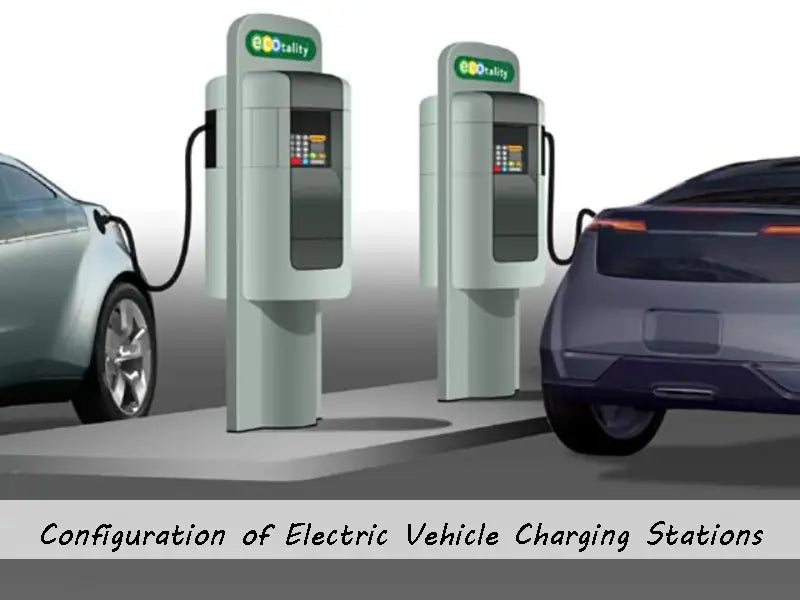
Main content:
With the development of science and technology, the research and development of electric vehicles has become less and less a problem. With the introduction of the familiar Tesla all-electric sports car and many other plug-in electric vehicles to the market, the more problems that need to be solved now are not Then there is the study of electric vehicles, but how to provide a must-have for these electric vehicles - electric vehicle charging stations. The electric vehicle charging stations are equivalent to a gas station serving ordinary gasoline vehicles. The electric vehicle charging stations that can easily supplement electric power for electric vehicles has become a necessary prerequisite for the popularization of environmentally friendly electric vehicles in the future.
1. Configuration of Electric Vehicle Charging Stations in Japan
Toyota is the world's top seller of hybrid vehicles, and Honda and Nissan also have their own green cars. In order to break through the constraints of electric vehicle charging, Tokyo will set up 1,000 electric vehicle charging stations. In 2009, 200 electric vehicle charging stations have been built, which will be expanded to 1,000 electric vehicle charging stations within three years. TEPCO has developed a fast charging system that enables electric vehicles to travel for 25 minutes on a 5-minute charge and 37 minutes on a 10-minute charge.
A key issue for the popularization of electric vehicles is the need to establish sufficient power supplementary facilities. To this end, Tokyo Electric Power Company announced that it will take the lead in participating in the infrastructure construction of electric vehicle charging stations. In 2010, more than 200 electric vehicle charging stations will be built in the metropolitan area. , which will increase to more than 1,000 in three years. Major Japanese automobile companies have also actively responded to participate in relevant research and projects, eagerly looking forward to the "de-oil" era to come to Japan as soon as possible. At present, Tokyo Electric Power Company has successfully developed a large-scale fast charger, which can travel 60km per 10 minutes of complete charging, which greatly shortens the charging time and further accelerates the pace of popularizing the use of electric vehicles in Japan.
It is reported that the cost of establishing the electric vehicle charging stations facility is 4 million yen. Tokyo Electric Power Company plans to build electric vehicle charging stations facilities in public places such as supermarket parking lots, convenience stores and post offices in Japan, so that people can let their cars replenish electricity when they get off the car for shopping.
Toyota Industries announced in late December 2009 the development of the solar electric vehicle charging stations for plug-in hybrid and pure electric vehicles. Twenty-one such solar electric vehicle charging stations will be built in 11 locations in Toyota City, Aichi Prefecture. The solar electric vehicle charging stations are grid-connected, and the 8.4kW battery can capture the electricity generated by the 1.9kW solar panel and then use it for charging. The maximum output of network power is 202VAC/3.2kW. Self-sustaining operation with solar power from the stack is a maximum output of 101VAC/1.5kVA. Excess solar power can be used in system facilities or sold to utility companies.
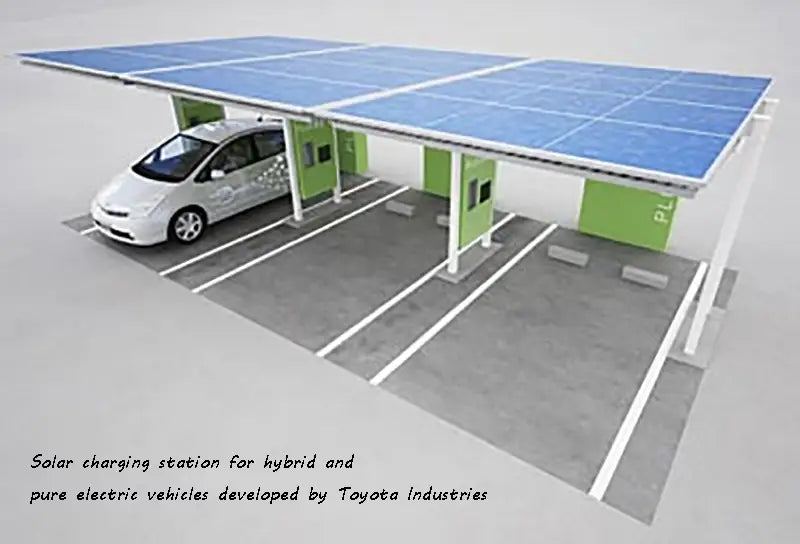
Showa Shell Petroleum and Nissan Motor Corporation announced on August 24, 2009 that they will jointly develop a fast charging system for electric vehicles using a combination of Showa Shell's new CIS solar cells and Nissan's latest vehicle lithium-ion rechargeable batteries. These electric vehicle charging stations system have the following three characteristics: First, it can maximize the use of sunlight and contribute to the popularization of completely zero-emission vehicle EVs that do not emit CO2 or other exhaust gas not only during driving but also during power generation. Second, the use of lithium-ion rechargeable batteries enables it to have a disaster response function that can supply power even in the event of a power outage, and it can also serve as a disaster prevention center for community residents. Finally, in order to equalize the load charged by the electric vehicle charging stations system, it can also lead to small-scale contract electricity. The joint development is part of the "2009 Electric Vehicle Popularization Environment Improvement Demonstration Business" commissioned by the Ministry of Economy, Trade and Industry. In addition, the rapid charging system technology combining the new CIS solar cells and lithium-ion batteries is expected to be used in homes or for large-scale solar power plants in the future.
Mitsubishi Corporation and Mitsubishi Assets Corporation announced on January 20, 2010 that they plan to build 1,000 electric vehicle charging stations for electric vehicles by 2012, in order to match highways and urban development. The investment is estimated to be in the billions of yen. In the first phase, charging stations will be built along the highway between Tokyo and Sun Hung. A typical electric vehicle can be charged within 30 minutes and can travel about 100km.
2. Configuration of Electric Vehicle Charging Stations in the United States
In early May 2009, Carbon Day Automotive launched the solar plug-in electric vehicle charging stations in Chicago, USA. These self-service electric vehicle charging stations allow drivers to easily charge their electric vehicles without any harmful emissions.
In May 2009, the Pacific Northwest National Laboratory released a charging control device for electric vehicles called "Smart Charg Controller". Mainly used for plug-in hybrid electric vehicles and electric vehicles. The device is designed to prevent the overload of the transmission network when the user is charging electric vehicles. Before electric vehicles were officially launched on the market, the United States was very concerned about overburdening the transmission grid with users charging their cars. Especially at night when most consumers go home from get off work and the TV and air conditioners are mostly turned on, if charging electric vehicles is added, the power demand will increase sharply, thereby increasing the burden on the transmission grid. Using the Smart Charger Controller developed by PNNL, users can manage the charging time of electric vehicles by themselves. The device can be used in conjunction with a transmission grid technology called "smart grid". By adopting the electric vehicle charging stations device, charging can be automatically avoided during peak hours. The results of the study show that even if 70% of the nation's vehicles were converted to electric vehicles, the current transmission grid could meet demand if charging during peak hours was avoided. If combined with the measures that the electricity bill during peak hours is higher than that of ordinary hours, it also has the advantage that charging can be moved outside the peak hours and users' electricity bills can be reduced. The Smart Charger Controller is equipped with a transmitter-receiver IC of ZigBee, a short-range wireless communication specification. It supports ZigBee's smart meter specification "Zig Bee Smart Energy Public Application Profile", so it can receive information such as electricity price setting from electric power companies. With ZigBee, users can also manage charging at home. In addition, the in-vehicle interface of CAN is also supported, and charging can also be managed in the car.
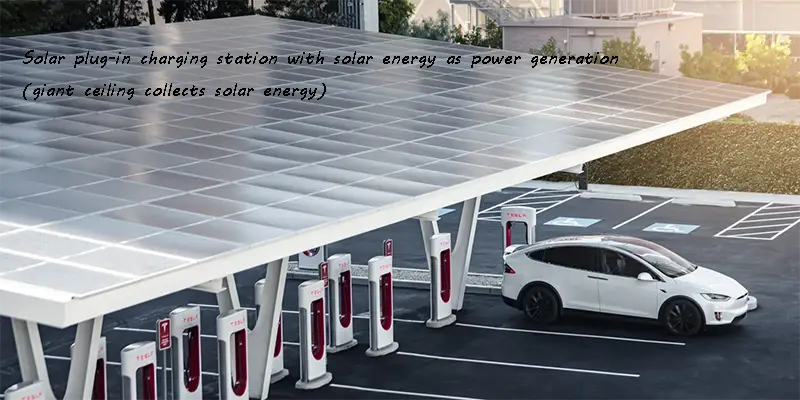
3. Configuration of electric vehicle charging stations in EU
On March 15, 2009, more than 20 leading companies in the automotive and energy fields stationed in EU countries announced the establishment of an alliance to jointly formulate standards for electric vehicle charging stations and charging equipment used by electric vehicles. The German automakers Daimler AG and RWE Energy are leading the development of the standard, and car companies participating in the alliance include BMW, Volkswagen, Renault-Nissan, Peugeot, Regal, Ford, General Motors, Toyota, Mitsubishi and Fiat. The coalition's energy companies are Germany's E.ON, EnBW and Vattenfall, EDF, Belgian Power, Italy's Enel, Spain's Endesa, Portugal's Power and the Netherlands' Essent. Alliance members will develop uniform standards for chargers, sockets, power cords, etc. for electric vehicle charging stations. At present, all parties have determined a new universal socket, which not only needs to meet the safety and convenience of use, but also meet the voltage range of 230~400V. The construction of electric vehicle charging stations is jointly carried out by automobile manufacturers and energy enterprises. At present, Germany's Daimler Group and RWE Energy have decided to jointly build 500 electric vehicle charging stations to prepare for the introduction of German electric vehicles to the market.
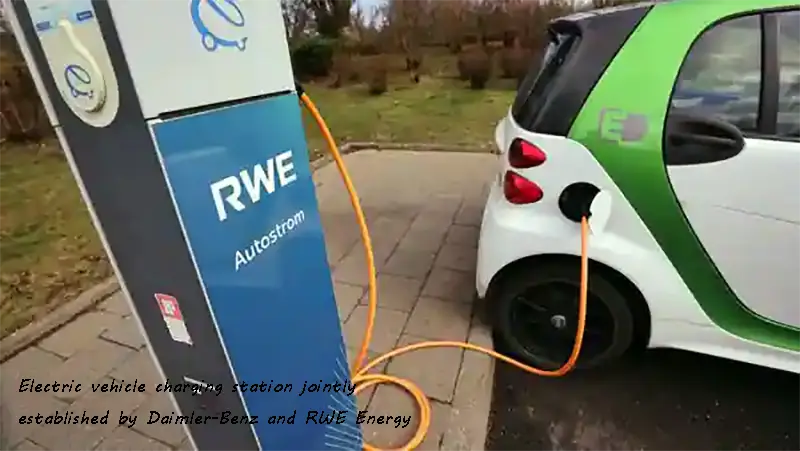
A Danish company called Valentin Runggaldier has launched the solar electric vehicle charging stations. The electric vehicle charging stations are mainly composed of 8 monocrystalline silicon solar panels, and its peak power can reach 1.76kW, which can charge 8 vehicles at the same time. At present, the company has installed such solar electric vehicle charging stations on the streets of Bozen, Denmark.
4. Configuration of EV charging stations in China
In 2010, China Power Grid will comprehensively promote the construction of electric vehicle charging stations in 27 provinces within the scope of the State Grid, and plans to build 75 public charging piles, 6,209 AC charging piles and some battery replacement stations; The city of demonstration and promotion of new energy vehicles has built the first two electric vehicle charging stations in December 2009, with a total of 134 charging piles.
Two electric vehicle charging stations with a total charging capacity of 2 480kV·A constructed by China Southern Power Grid were completed and put into operation in Shenzhen in January 2010. Among them, Shenzhen Longgang Universiade Center electric vehicle charging station can accommodate 12 electric vehicles at the same time, covers an area of 1092m2, and has a total investment of 10.515 million yuan. It is currently the largest electric vehicle charging stations in China in terms of area and investment. Shenzhen Longgang Universiade Center Electric Vehicle Charging Stations can provide charging services for taxis, cars and buses. Another electric vehicle charging stations are located in Longgang Central City, Shenzhen, with 3 fast chargers, which can accommodate 6 electric cars at the same time. According to reports, by 2012, Shenzhen will promote the use of new energy vehicles will exceed 24,000, reaching 100,000 in 2015, accounting for more than 6% of Shenzhen's existing car ownership. In order to meet the development needs of new energy vehicles, Shenzhen will build 12,750 charging stations for various types of new energy vehicles.
Although the electric vehicle charging stations is a new thing, its market prospect in the new energy era will be quite similar to the current gas station. For this huge market, State Grid and China Southern Power Grid are accelerating their expansion, intending to replace the three oil giants in the new energy era and become a new energy giant. However, the Big Three are also stepping up their game to grab a piece of the pie. PetroChina and CNOOC are also interested in extending the tentacles of energy supply to the promising new energy vehicle field. Among them, CNOOC and Sinopec have made it clear that they want to take a share in the energy supply field of electric vehicles. Perhaps in a few years, the large and small gas stations in every corner of the city will be renamed "energy supply stations" or "gas and electricity supply stations", because by then, the function of gas stations will no longer be as simple as just refueling cars. Rather, it acts as a charging station for electric vehicles or a filling station for natural gas vehicles.
In order to ensure the large-scale application of pure electric vehicles in Beijing, Sinopec and the Beijing Municipal Government are jointly promoting the construction of electric vehicle charging stations. This means that Sinopec, China's largest refined oil sales company, has officially joined the construction of a network of electric vehicle charging stations. Beijing Shouke Group Co., Ltd. and Sinopec Beijing Petroleum Branch have jointly funded the establishment of Beijing Sinopec Shouke New Energy Technology Co., Ltd., which will mainly use Sinopec's existing large-area refueling and refueling stations to be transformed into comprehensive refueling and charging service stations; plans to adopt The development and operation mode of "electricity with oil and combination of oil and electricity", that is, the operation of oil products to drive the charging and replacing business, and solve the problem of operating costs of electric vehicle charging stations. In the future, the two parties will take advantage of Sinopec's network advantages in urban and rural areas to gradually increase the number of comprehensive service stations for refueling and charging, and expand the comprehensive service stations for refueling and charging to the whole city of Beijing, and further to Hebei, Tianjin and even larger areas, so as to increase the number of pure electric vehicles. The activity radius of passenger cars will accelerate the promotion and popularization of pure electric vehicles.
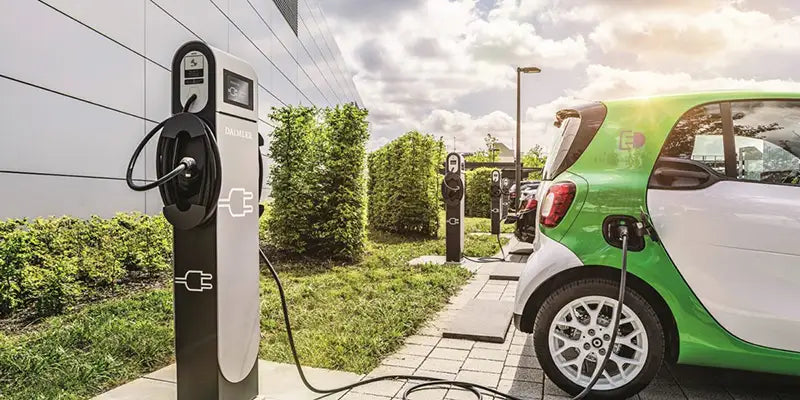
Two modes are planned for the proposed electric vehicle charging stations. One is that after the pure electric vehicle enters the electric vehicle charging stations, the car battery is charged by a professional charger, just like going to the gas station to refuel the car. However, the disadvantage of this mode is that the charging time is longer, and the owner needs to wait for a long time in the charging station. In order to solve the problem of too long charging time, another mode is that when the pure electric vehicle enters the electric vehicle charging stations, the staff removes the rechargeable battery in the car and directly replaces the new battery in the electric vehicle charging stations. But if this model is adopted, a large number of batteries need to be stored in the electric vehicle charging stations. Obviously, no matter which mode, the site requirements for the charging station are relatively high, and the gas stations currently spread all over the country's urban and rural traffic arteries are considered by some industry insiders to be ideal places to open charging stations. Statistics show that Sinopec has a total of about 30,000 gas stations, and PetroChina has a total of about 18,000 gas stations. If such a huge network of gas stations is transformed into a combined oil and electricity station in the future, it will inevitably have an impact on the performance of the two groups.
Read more: New products and applications of all-electric vehicles